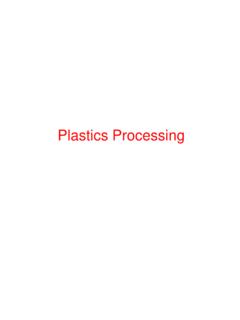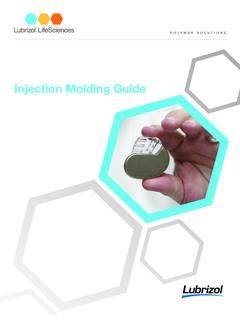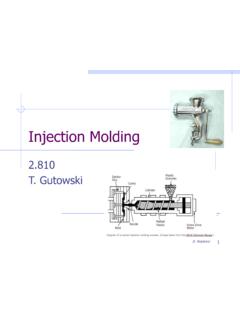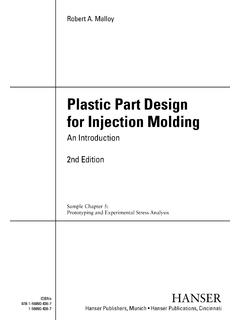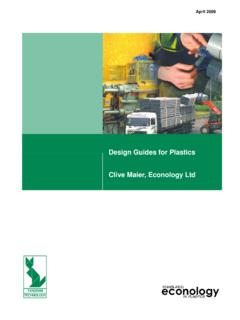Transcription of Blow Molding Design Guide by Regency Plastics
1 BLOW Molding Design GUIDEFor Engineers, By to Use This GuideIf you ve been tasked to Design a hollow part for high-volume production (3,000+ parts per year), you ve come to the right place. Blow Molding allows for complex hollow parts with tight tolerances to be produced at a lower cost and with faster cycle times than other Molding methods such as rotomolding. It s no wonder so many engineers are turning to blow Molding to solve their high-volume production is the key driver of the cost and quality of blow molded parts. It has the power to give your company a competitive advantage or it can bring your project to a screeching halt. But where do you begin? You may have questions such as: Will blow Molding work for my part? What does the blow Molding process look like? What special Design considerations do I need to make?
2 We were there once, too. That s why we created this Guide . It provides the basic guidelines for designing blow molded plastic parts from the perspective of an experienced molder. It is not exhaustive; the amount of information available is simply too great. However, it serves as a starting point to better understand what goes into the blow mold Design you re new to blow Molding , start with the Understanding Blow Molding section. It outlines the benefits of blow Molding , provides an overview of its applications, and illustrates the blow Molding you have an understanding of the blow Molding process and just need to learn how to optimize your Design , jump to Blow Molding Design to learn Design principles for the most critical aspects of blow Molding . Questions?We ve found the most important factor for success in blow Molding is partnering with our customers early in the Design stage.
3 So don t hesitate to reach out to us if you have questions regarding what you find on the following pages or how it relates to your specific technical sales team is standing by at and !BLOW Molding Design Guide : INTRODUCTION2 BLOW Molding Design Guide : CONTENTSC ontentsUNDERSTANDING BLOW MOLDINGBlow Molding Process 3 Advantages of Blow Molding 5 Technical Blow-Molded Products 5 BLOW Molding DESIGNM aterial Selection 6 Blow Ratio 7 Draft of Part
4 8 Radii / Corners 9 Ribs / Tack-Offs 9 Shrinkage 10 Insert Molding 11 Texture 11 Pinch Design 12 Secondary Operations 12 SUMMARYBlow Molding Terminology 13 Case Study 14A Word of Advice Molding Design Guide : UNDERSTANDING BLOW Molding PROCESSBlow Molding is an umbrella term for forming hollow plastic parts by inflating a molten plastic tube, or parison, until it fills a mold and forms the desired shape.
5 Think of it like inflating a balloon inside of a water bottle. There are three main types of blow Molding : extrusion Blow MoldingStretch Blow MoldingInjection Blow MoldingIn extrusion blow Molding , the parison is extruded vertically between the two open mold halves. The mold closes and the parison is inflated until it takes the shape of the mold Blow MoldingExtrusion Blow MoldingSTEP 1 Parison is extruded into moldSTEP 2 Blow mold seals around parisonSTEP 3 Parison is inflated with airSTEP 4 Parison cools and mold opensInjection blow Molding is the least commonly used method and is used to manufacture small containers in small blow Molding is typically used to create plastic containers with simple geometries such as jars and blow Molding is the most common type of blow Molding and is used to manufacture complex parts in large Molding Design Guide : UNDERSTANDING BLOW stretch blow Molding , the parison is formed by injecting plastic around a core.
6 When the injection mold opens, both the parison and core are transferred to the blow mold and securely clamped. The parison is then heated and stretched downward by the core. Finally, the air vents in the core open and inflate the parison into the desired injection blow Molding , the parison is formed by injecting plastic around a core. When the injection mold opens, both the parison and core are transferred to the blow mold and securely clamped. Finally, the air vents in the core open and inflate the parison into the desired Blow Molding (continued) injection Blow MoldingStretch Blow MoldingSTEP 1 Parison is injection moldedSTEP 1 Parison is injection moldedSTEP 2 Parison is placed into blow moldSTEP 2 Parison is placed into blow moldSTEP 3 Blow mold seals around parisonSTEP 3 Mold seals around parison, parison is stretched downwardSTEP 4 Parison is inflated with airSTEP 4 Parison is inflated with airSTEP 5 Parison cools and mold opensSTEP 5 Parison cools and mold Molding Design Guide : UNDERSTANDING BLOW MOLDINGU nderstanding Blow Molding (continued) of Blow MoldingWith an increasing focus on lightweighting and sustainability, engineers across the globe in nearly every industry have turned an eye towards blow Molding .
7 Its many benefits Low cost for high volume productionFor mass-produced hollow parts, blow Molding is more cost-efficient than other processes such as rotomolding and thermoforming. Design flexibilityComplex part geometries can be achieved to adapt to unusual spaces between already existing components. High strength-to-weight ratioParts can be reinforced with a lightweight foam core or internal ribs to increase structural strength and impact resistance. Insulation and acoustical propertiesHollows can be vacuumed or filled with a material to achieve high insulation and noise reduction Blow-Molded ProductsTypically, when people think blow Molding , they think of water bottles, cosmetic containers, toys, and other consumer goods. It might come as a surprise to learn that blow Molding is used to produce some highly technical products, too, including the following:Seating, consoles, panels, foam-filled partsTubes, boots, sleeves, housingsIntake ducts, resonators, tuners, HVAC ductsDEF tanks, washer reservoirs, surge tanksStructural ComponentsFunctional ComponentsUnder Hood Air DuctsFluid Molding Design Guide : BLOW Molding DESIGNBlow Molding Molding DesignNow that you ve read a high-level overview of the blow Molding process, it s time to start your Design .
8 It might seem a bit daunting at first, but you don t have to get it right the first time around. Just take your best shot, then present your Design to your supplier. Companies such as Regency Plastics , a Gemini Group company, will work with you to ensure that your Design is optimized for your application and for the blow Molding process. Regency will even run your Design through simulation software to eliminate problem areas before any tooling is built. To accelerate the process, just follow these general guidelines and your Design should be in pretty good shape once it hits your supplier s SelectionWhen choosing a material for blow Molding , it s important to remember the material will be stretched. If the elastomeric properties of the material are exceeded, a hole will tear through the material resulting in a defective part.
9 Other relevant properties are largely based on your application and might include mechanical, physical, chemical resistance, heat, electrical, flammability or UV are some questions you should consider:If a material meets most requirements but falls short somewhere, an additive may be able to change its properties. For example, nylon 6/6 flows well, is good for thin-walled parts, and has excellent impact resistance, but you might have rejected it because of its average strength and lack of resistance to heat. Adding glass-fiber filler to the resin not only makes the nylon much stronger, but far more heat resistant. Glass also reduces the chance of sink in thick sections, but may lead to warp in thin areas, depending on material flow during the Molding are hundreds of materials and thousands of ways to adjust, blend or fine-tune them to produce the desired results.
10 Resin manufacturers, compounders and independent resin search engines have material data online. It is highly recommended that you consult with your supplier when choosing a material. They can either advise you directly or put you in touch with an expert at one of their material suppliers. Temperature exposure: What are the minimum and maximum temperatures the part will be exposed to? Remember, the first shot substrate must be able to withstand temperatures above the second shot s melt point. Bending stiffness: Does the material need to be flexible or rigid? What should the bending strength or deflection be? Impact resistance: What level of hardness or surface toughness does each component require? Will the part need to withstand impact forces without shattering or breaking? Tensile and compression strength: Will either component need to withstand pull-apart or compression forces?

